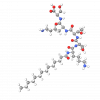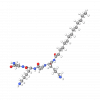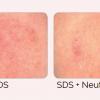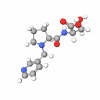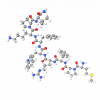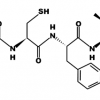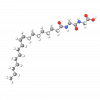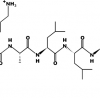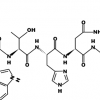Myristoyl Nonapeptide-3 is a synthetic biomimetic lipo-peptide with retinol-like action, known under the trade name RetinoPeptide™ 189. Mimicking famous anti-aging vitamin A's biological activity boosts collagen type I production, exposing a firmer, smoother, and youthful appearance.
Peptides
There are numerous examples in physiology of peptide regulatory elements that play integral roles in basic homeostatic mechanisms such as injury-repair responses and other stimulus-response actions. Among these are well-known neuropeptides (e.g., bradykinins, endorphins); metabolism and fat storage regulators (e.g., neuropeptide Y, leptin, insulin); tanning and skin pigmentation-related peptides (e.g., α-MSH, ACTH, Agouti), and peptides involved in wound healing (e.g., FGF).
This large group of innovative cosmeceutical ingredients triumphed in the world of skincare products during the last two decades. Peptides are chains of amino acids that are attached in a specific order. Amino acids are naturally occurring in the body and are vital to everyday living processes. Peptides can be made up of 2 or more amino acids that can stimulate different responses within the body. As a result, peptides serve as tiny messengers that can be sent to kick the skin into gear and make it look better.
Peptides are leading a beauty revolution due to their excellent multi-functional properties; formularies are scrambling to access the latest advances in cosmetic peptide technology. In addition, their "Botox-like" performance, activation of collagen and elastin production, and skin-lightening effect make them very efficient against coarse wrinkles and hyperpigmentation of the skin.
Myristoyl Octapeptide-1 is a synthetic lipo-peptide that mimics growth factors, promoting dermal tissue repair processes and accelerating wound healing. It binds to the specific receptors on fibroblasts, boosting skin cell proliferation and activity.
Myristoyl Pentapeptide-17 is a bioavailable lipo-oligopeptide (sequence Myr-Lys-Leu-Ala-Lys-Lys-NH2) with eyelash-enhancing action. In addition, it has anti-aging, anti-inflammatory, and anti-bacterial properties.
Myristoyl Pentapeptide-4 (former Myristoyl Pentapeptide-3) is a synthetic lipo-peptide sold under the trade name Collasyn 514KS, an ester of Mystiric acid (attached to the N-terminus) and KTTKS peptide with sequence Myr-Lys-Thr-Thr-Lys-Ser.
Myristoyl Pentapeptide-8 is a synthetic lipopeptide that mimics cell-adhesion protein action, exposing a smoother, healthier, and more resilient skin appearance. It is known under the trade name SymPeptide® 222.
Myristoyl Tetrapeptide-12 is a synthetic lipo-peptide with sequence Myr-Lys-Ala-Lys-Ala-NH2 specially developed for improving the appearance of eyelashes and eyebrows. It promotes hair growth and provides a thicker, longer, and voluminous appearance.
Myristoyl Tetrapeptide-13 is a synthetic cationic lipopeptide with a potent antimicrobial activity. It is designed to work alone or in synergy with other antibacterial agents to act as an anti-acne active or performance-enhancing preservative.
Indoor tanning provides a year-round, convenient, controlled environment for people of all types who want to enjoy the look and feel of a tan body. Myristoyl Tetrapeptide-20 is a topically active short peptide that exerts effective tanning without harmful UV irradiation.
Collagen is one of the main components of the ECM (extracellular matrix) of the skin connective tissue and its concentration decreases with aging. The loss of collagen has two reasons reduction of the production and increased degradation.
Transforming growth factor (TGF-β), a member of a large family of secreted peptide growth factors is known to play a prominent role in the accumulation of ECM (extracellular matrix) components by increasing the expression of ECM genes, such as collagen, elastin, fibronectin, and proteoglycan.
Photoaging occurs via the clinical and histological effects of chronic sun exposure and is responsible for most age-related changes, including wrinkles, roughness, and hyperpigmentation.
Some neuropeptides produced locally, within the skin, have natural anti-inflammatory activities. Proopiomelanocortin (POMC), a neuroendocrine protein found in the skin in response to local stressors, is an important precursor of such neuropeptides.
Nicotinoyl Dipeptide-23 is a vitamin-peptide conjugate niacinamide (Vitamin B3) introduced into the N-terminus of peptide through chemical synthesis. It is known under the trade name V-peptide-2.
Octapeptide-11 is a synthetic peptide with sequence Met-Ile-Pro-Cys-Tyr-Ile-Ser-Ser known under the trade name CG-Seperin. It acts as an inhibitor of the MMP (Matrix MetalloProteinase) enzyme responsible for hyaluronic acid degradation.
Octapeptide-2 is a synthetic peptide that strengthens hair and promotes its growth. It is also known under the trade name Prohairlin-β4.
Oleoyl Dipeptide-15 (Glycyl glycine oleamide) is a synthetic lipopeptide that fights against skin structural proteins glycation and elastosis. It is known under the trade name Relastide®.
Oligopeptide-10 is a 15-amino-acid-long peptide with the sequence Phe-Ala-Lys-Ala-Leu-Lys-Ala-Leu-Leu-Lys-Ala-Leu-Lys-Ala-Leu. It is a water-soluble white powder, compatible with all emulsion types in the 5-7 pH range.
Oligopeptide-104 is a synthetic 11 amino acid-long peptide with sequence Ac-Gln-Gln-Arg-Phe-Glu-Trp-Glu-Phe-Glu-Gln-Gln-NH2 that self-assembles into a 3D matrix with multiple calcium-binding sites as a nucleation point for Hydroxyapatite, triggering the natural tooth regenerative,
Oligopeptide-177 is a synthetic peptide with 33 amino acids whose sequences repeat a fragment of the erythropoietin (EPO) glycoprotein.
Oligopeptide-18 is a synthetic peptide that promotes hair removal by inhibiting the maturation of hair follicle cells. This peptide is also known under the trade name Retadrin.
Oligopeptide-19 is a synthetic peptide that fights against unwanted hair by slowing down hair follicle cell maturation. This peptide is also known under the trade name Alopectin.
Oligopeptide-20 is a synthetic peptide that contains 12 amino acids and mimics Somatomedin (a growth factor) involved in normal skin growth, healing, and wound repair.
Oligopeptide-21 is a synthetic peptide developed for the reduction and prevention of lines and deep wrinkles. This peptide is also known under the trade name CG-IDP 4.
Oligopeptide-22 is a synthetic peptide with anti-wrinkle, anti-aging, and wound-healing properties. It is known under the trade name CG-IDP 3.
Oligopeptide-24 (former Oligopeptide-23; known under the trade name CG-EDP3) is a synthetic biomimetic peptide that stimulates skin cell proliferation by up-regulation of EGF (Epidermal Growth Factor) expression.
Oligopeptide-34 is a synthetic peptide (known under the trade name CG-TGP2) that decreases melanin synthesis by down-regulation of TRP-1, TRP-2, MITF, and Tyrosinase.
Oligopeptide-41 is a synthetic peptide with sequence Ala-Ser-Ala-Lys-Trp-Thr-His-Asn-Gly-Gly-Glu-Met-Phe that suppresses Dickkopf 1 (DKK-1), which itself acts as a WNT Signaling Pathway Inhibitor. This peptide is also known under the trade name CG-Keramin1.
Oligopeptide-42 is a synthetic peptide known under the trade name CG-Fibramin that stimulates hair growth and protects hair from loss of pigment.
Oligopeptide-45 is a synthetic biomimetic peptide that speeds up the development and proliferation of dermal keratinocytes and fibroblasts. It is also known under the trade name CG-Dermaheal.

